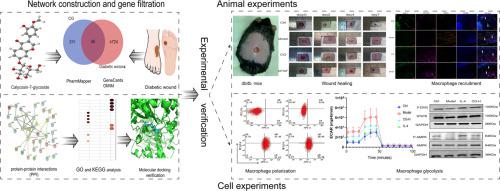Phytomedicine ( IF 6.7 ) Pub Date : 2023-03-20 , DOI: 10.1016/j.phymed.2023.154773 Jia Chen 1 , Huike Ma 2 , Yujiao Meng 2 , Qingwu Liu 1 , Yan Wang 2 , Yan Lin 2 , Danyang Yang 2 , Wentao Yao 2 , Yazhuo Wang 2 , Xiujuan He 2 , Ping Li 1

|
Background
Diabetic wounds represent a severe clinical challenge in which impaired M2 macrophage polarization and continuous macrophage glycolysis play crucial roles. Calycosin-7-glucoside (CG) is an isoflavone component in Astragali Radix (AR), which has become a research focus for treating diabetic wounds following reports indicating that it has anti-inflammatory effects. However, the mechanism through which CG can treat diabetic wounds is yet to be deciphered.
Purpose
This study aimed to evaluate the therapeutic effect of CG on diabetic wounds and its underlying mechanism.
Methods
The potential mechanism underlying the treatment of diabetic wounds by CG was screened using bioinformatics. The therapeutic effects of CG were then investigated using a db/db diabetic wound model. Moreover, an LPS- and IFN-γ-induced RAW264.7 cell inflammation model was used to elucidate the mechanism underlying the therapeutic effects of CG against diabetic wounds.
Results
Network pharmacology predicted that the AMPK pathway could be the main target through which CG treats diabetic wounds. In db/db diabetic mice, CG could accelerate wound healing and promote granulation tissue regeneration. Protein chip technology revealed that CG increased the production of M-CSF, G-CSF, GM-CSF, IL-10, IL-13, and IL-4 but not that of MCP-1, IL-1β, IL-1α, TNF-α, and TNF-RII. Moreover, CG elevated the proportion of Ly6CLo/- anti-inflammatory monocytes in peripheral blood and M2 macrophages in the wound. The ELISA and flow cytometry analyses revealed that CG enhanced the levels of IL-10, VEGF, CD206, and Arg-1 expression whereas it considerably reduced the levels of IL-1, IL-6, IL-12, TNF-α, CD86, and iNOS expression. Meanwhile, CG increased the macrophage mitochondrial membrane potential and decreased the mitochondrial ADP/ATP ratio and glycolysis rate of M1 macrophages through the ROS/AMPK/STAT6 pathway.
Conclusions
The network pharmacology and molecular dockin identified the AMPK pathway as a critical pathway for treating diabetic wounds using topical CG application. CG was found to promote anti-inflammatory monocyte recruitment and decrease the mitochondrial glycolysis rate to induce M2 macrophage polarization via the ROS/AMPK/STAT6 pathway. These results suggest that CG might be a promising therapeutic agent for diabetic wounds.
中文翻译:

使用网络药理学和分子对接分析 Calycosin-7-糖苷促进糖尿病创面愈合的机制
背景
糖尿病伤口是一项严峻的临床挑战,其中受损的 M2 巨噬细胞极化和持续的巨噬细胞糖酵解起着至关重要的作用。Calycosin-7-glucoside (CG) 是Astragali Radix (AR)中的一种异黄酮成分,在有报道表明其具有抗炎作用后,它已成为治疗糖尿病伤口的研究热点。然而,CG 治疗糖尿病伤口的机制尚待破译。
目的
本研究旨在评估 CG 对糖尿病创面的治疗效果及其潜在机制。
方法
使用生物信息学筛选了 CG 治疗糖尿病伤口的潜在机制。然后使用 db/db 糖尿病伤口模型研究 CG 的治疗效果。此外,LPS 和 IFN-γ 诱导的 RAW264.7 细胞炎症模型用于阐明 CG 对糖尿病伤口治疗作用的潜在机制。
结果
网络药理学预测 AMPK 通路可能是 CG 治疗糖尿病创面的主要靶点。在 db/db 糖尿病小鼠中,CG 可加速伤口愈合并促进肉芽组织再生。蛋白质芯片技术显示,CG 增加了 M-CSF、G-CSF、GM-CSF、IL-10、IL-13 和 IL-4 的产生,但不增加 MCP-1、IL-1β、IL-1α、 TNF-α 和 TNF-RII。此外,CG 提高了 Ly6C Lo/-的比例外周血中的抗炎单核细胞和伤口中的M2巨噬细胞。ELISA 和流式细胞术分析显示,CG 提高了 IL-10、VEGF、CD206 和 Arg-1 的表达水平,同时显着降低了 IL-1、IL-6、IL-12、TNF-α、CD86 的水平, 和 iNOS 表达。同时,CG通过ROS/AMPK/STAT6途径增加巨噬细胞线粒体膜电位,降低M1巨噬细胞线粒体ADP/ATP比值和糖酵解率。
结论
网络药理学和分子对接将 AMPK 通路确定为使用局部 CG 应用治疗糖尿病伤口的关键通路。发现 CG 可促进抗炎单核细胞募集并降低线粒体糖酵解速率,从而通过 ROS/AMPK/STAT6 通路诱导 M2 巨噬细胞极化。这些结果表明,CG 可能是一种很有前途的糖尿病伤口治疗剂。











































 京公网安备 11010802027423号
京公网安备 11010802027423号